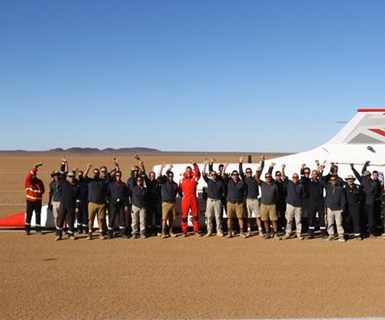Bloodhound LSR hits 638 mph in test run
Having completed a run of speed tests, the jet-powered car will now be reassembled and fitted with a rocket before attempting to break the land speed record.

Source | Bloodhound LSR
The recently reported speeds of 638 miles per hour in the most recent speed tests of its Rolls-Royce EJ200 jet-powered car, on its way toward breaking the world land speed record of 763.035 miles per hour.
According to the project leaders, this places the Bloodhound LSR car, unofficially, as the sixth fastest car of all time.
The tests took place on a 16-kilometer-long, 500-meter-wide track created in the Hakskeenpan lakebed in the Kalahari Desert in South Africa. The team has been testing the car here in progressively faster runs beginning in October 2019.
Driven by Andy Green, the Bloodhound LSR car reached a maximum speed of 628 miles per hour (1,010 kilometers per hour) from a standing start in 50 seconds. However, the team says that the primary aims were not speed, but to develop the team, hone operational processes, deliver crucial data and prepare the car for the record attempt within the next 18 months.
“With the data we’ve generated from the high-speed testing, we’re able to start budgeting for the next phase of the project, which will need to be funded through sponsorship,” says Bloodhound LSR owner Ian Warhurst. “We know it will require up to £10 million, and the incredible social engagement with our high-speed testing program has proved that sponsors will see a return on investment and be a part of history.”
To record the data, the Bloodhound LSR car is covered with 192 air pressure tappings, plus a multitude of strain gauges, temperature sensors and accelerometers. These provided data on the pressures and loads that the Bloodhound LSR car was under at high speed. The data from these sensors was reviewed following every run to check if they married up with the predicted computer generated CFD (Computational Fluid Dynamics) models and suspension loadings.
Jack Townsend and Assistant Professor Ben Evans from (Swansea, U.K.) reviewed the data and reported a correlation of more than 90% between the predicted CFD model and the data generated, exceeding expectations. According to Bloodhouns LSR, this gives greater confidence in the aerodynamic shape of the car as speeds increase, as well as a belief that a targeted new land speed record of 800 miles per hour, or even faster, is possible.
Next, the team is concentrating on raising funds to move into the final phase of the program. The Bloodhound LSR car is being shipped back to the U.K. by sea, set to arrive in early January 2020. At SGS Berkeley Green University Technical College in Gloucestershire, the car will be reassembled into desert spec configuration.
In addition, Norwegian aerospace expert Nammo is developing a monopropellant rocket as part of a European Space Agency R&D program, which will be fitted to the Bloodhound LSR into the tunnel beneath the EJ200 jet engine. The new rocket will use concentrated hydrogen peroxide (H2O2) which, when passed through a catalyst, decomposes into H2O and oxygen, while generating the several thrust needed to propel Bloodhound LSR toward its record-breaking goals.
Related Content
-
Infinite Composites: Type V tanks for space, hydrogen, automotive and more
After a decade of proving its linerless, weight-saving composite tanks with NASA and more than 30 aerospace companies, this CryoSphere pioneer is scaling for growth in commercial space and sustainable transportation on Earth.
-
SMC composites progress BinC solar electric vehicles
In an interview with one of Aptera’s co-founders, CW sheds light on the inspiration behind the crowd-funded solar electric vehicle, its body in carbon (BinC) and how composite materials are playing a role in its design.
-
Braided thermoplastic composite H2 tanks with co-consolidated molded boss areas to fit EV battery space
BRYSON project demonstrates possible designs, automated manufacturing and low permeability concepts, including EVOH liner and novel PPA matrix.
.jpg;width=70;height=70;mode=crop)





